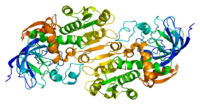
Photo from wikipedia
CeO2 nanorods supported Co–CoOx catalysts showed high selectivity for higher alcohol synthesis (HAS) from syngas. The selectivity has found to increase with lowering the Co loadings, and the value over… Click to show full abstract
CeO2 nanorods supported Co–CoOx catalysts showed high selectivity for higher alcohol synthesis (HAS) from syngas. The selectivity has found to increase with lowering the Co loadings, and the value over Co1/CeO2 (19.86%) is twice higher than that over Co5/CeO2 (8.67%). The active sites at the interfaces between Co0 and CoOx, or to say, Co–CoOx pairs, have evidenced to be responsible for HAS. The strong metal–support interactions between Co and CeO2 retard the reduction of CoOx and stabilize the intermediates such as CO–Coδ+. Likely, CO favors dissociating on the metallic Co surface to form CHx species, while CO is associatively activated on Coδ+ sites. Moreover, the structure evolution of the Co–CoOx interface was revealed during calcination, reduction, and reaction using in situ X-ray diffraction (XRD), in situ Raman spectroscopy, X-ray absorption spectroscopy (XAS), and in situ diffuse reflectance infrared fourier transform spectroscopy (CO-DRIFTS). The structure–performance relationship of HAS over Co/C...
Journal Title: ACS Catalysis
Year Published: 2018
Link to full text (if available)
Share on Social Media: Sign Up to like & get
recommendations!